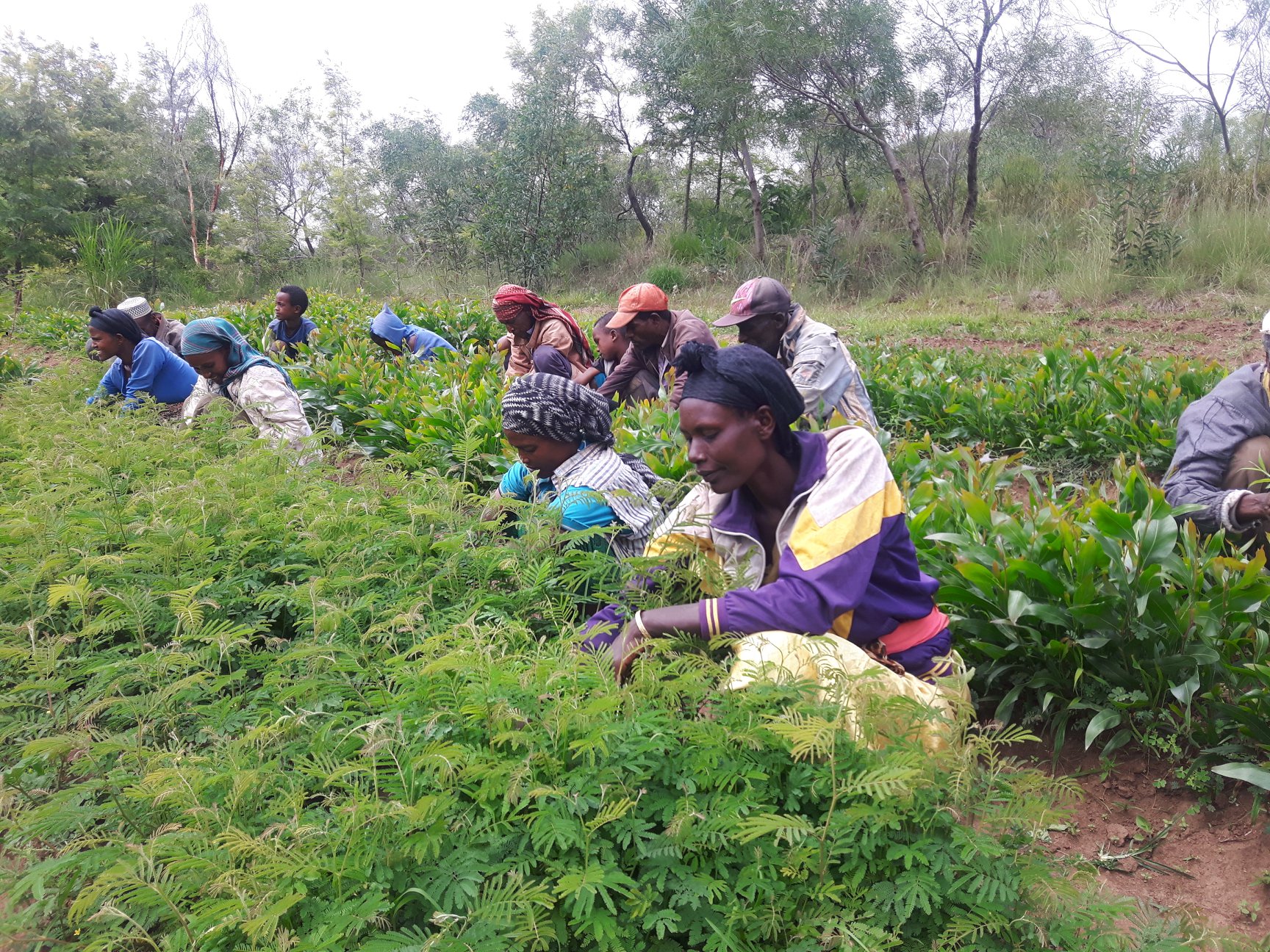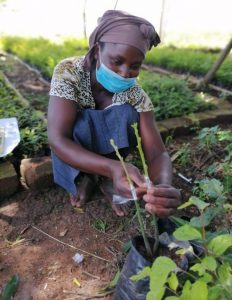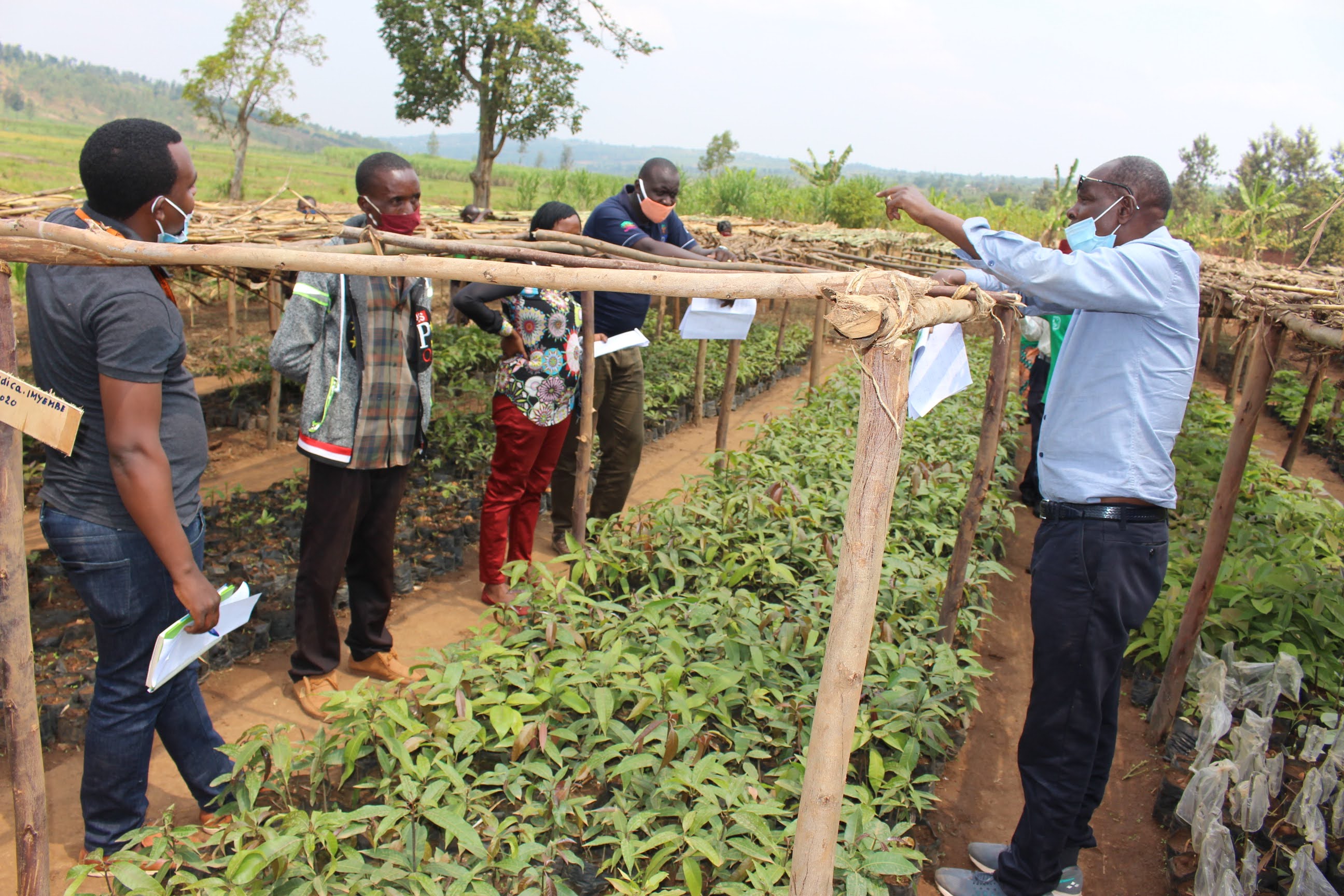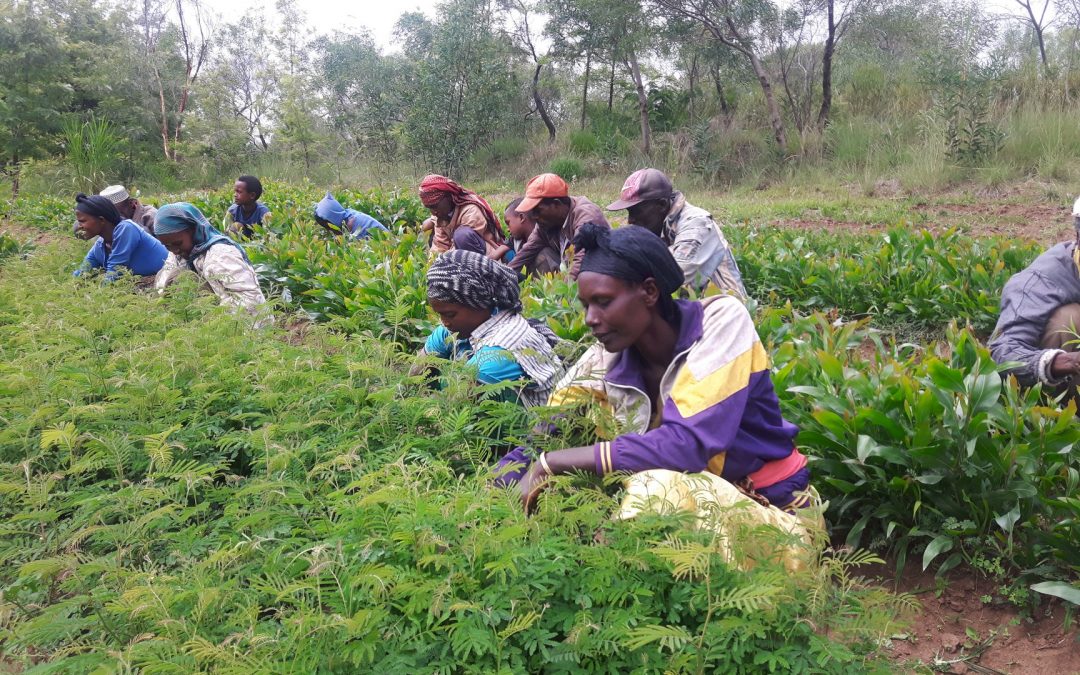By May Muthuri and Mieke Bourne
A policy brief from World Agroforestry Regreening Africa Project outlines key findings and recommendations to enhance the enabling policy, legal and institutional environment to underpin scaling-up of agroforestry in sub-Saharan Africa.

Farmers attending to a tree nursery in readiness for the nationwide tree planting campaign in Ethiopia. Photo Habtamu Regasa/ World Vision Ethiopia
Integrating trees in farming and pastoral landscapes – agroforestry is one of the most effective tools we have for climate mitigation and adaptation, and for restoring degraded lands, while providing nutrition and livelihoods benefits to millions of people in sub-Saharan Africa. Interestingly, the integral role agroforestry plays is often under recognised, with several policy barriers to accelerated adoption, even in areas with significant potential for these practices.
A review of policies and technologies completed as part of the European Union (EU) funded Regreening Africa Programme, being implemented in Kenya, Rwanda, Ethiopia, Somalia, Niger, Mali, Senegal and Ghana, provided policy and institutional insights and recommendations for scaling.
Some of findings are that firstly, agroforestry does not have its own policy space. It is spread across agriculture, forest, natural resources and climate change sectors. As a result, a country can lack policies related to agroforestry, or may have existing strategies that limit farmers from cultivating trees on their land or accessing, using and selling tree-based products. And, in other extremes, incoherent policies that prohibit one aspect of agroforestry while exalting another, thus, creating an incomprehensible maze!
Secondly, fragmentation and ineffective coordination among government institutions and stakeholders dealing with different elements of agroforestry, curtails efficiencies in financial resource-use, duplication or poor attention to needed efforts.

A farmer grafting a tree seedling in a communally owned nursery in Kenya. Photo: Charles Odhiambo/ World Vision Kenya
Thirdly, farmers are left in a pool of uncertainty on whether to make long-term investments on trees, due to unsecured or ambiguous land and tree tenure. Not forgetting the bureaucratic and expensive permit systems that cripple a farmers’ passion to get what he or she rightfully deserves. Naturally, this restricts the success of agroforestry initiatives.
Fourthly, technical agroforestry advisory services are often underfunded, under-capacitated, and unfacilitated, yet this crucial resource is meant to demonstrate and disseminate, various technological options that involve agroforestry.
Lastly, agroforestry value chain opportunities exist but they are poorly developed. There are gaps in linking farmers to private sectors to offtake the produce, coupled with poor infrastructure and low market prices for tree-based products.
Well, it’s not all gloom and doom. Key findings and recommendations in this policy brief (French version) outline opportunities to enhance enabling policies, legal and institutional environments, to underpin scaling-up of agroforestry in sub-Saharan Africa. Drawing from examples in the eight Regreening Africa project countries, it is evident that some steps in the right direction are being made. Legislative approval processes that encompass comprehensive agroforestry strategies and action plans are underway, and the roadmap to this is:
1) Reviewing, aligning and revising policies that can coherently and effectively benefit the accelerated expansion of agroforestry.
2) Ensuring a coordinated implementation of agroforestry development through platforms or mechanisms that function effectively across sectoral ministries, in collaboration with the private sector, non-governmental and grassroot organisations, and other actors that are critical to success in implementing agroforestry development on the ground.
3) Reforming rights to access and use trees and land to reflect the needs of men, women, youth and vulnerable groups. This will serve as an incentive to invest in agroforestry, to their benefit and to that of the national economy and environment.
4) Increasing investments in rural advisory services, research and robust monitoring systems to boost farmers’ capacity in implementing agroforestry.
5) Eliminating policies hindering the progression of tree-based value chains, may pave way to investments, credit access and market information that will not only uplift farmers, but a country’s economy.

Staff from World Vision Rwanda indulge farmers in discussions during the joint reflection and learning missions. Photo Elisee Bahati/ World Agroforestry
6) Implementing and supporting agroforestry activities at national, sub-national and local levels that contribute to the achievement of national aspirations and commitments linked to international agendas. This way, countries are presented with opportunities for leveraging finance, promoting cross-sectoral linkages and developing integrated monitoring systems at the national level.
There are examples in the countries that align to these recommendations. For instance, National Oversight and Coordination Committees in the 8 countries link the project to government officials and could be strengthened to provide a long-term coordination role for national restoration activities. In Ethiopia, a National Watershed and Agroforestry Multi-Stakeholder Platform has been established to facilitate awareness-raising, coordination, and harmonization across sectors, as well as creating an enabling policy environment within which agroforestry can flourish.
As observed in Senegal, Mali and Ghana, local knowledge when harnessed in the development and promotion of agroforestry options, encourages women and vulnerable groups to practice, mostly because of the promising results and opportunities on food security, resilience and income. In Ghana, as in Niger, a reform process is underway that may enhance ownership, access and use of trees by landowners. Rwanda recently developed an agroforestry strategy and action plan to be implemented under the Rwanda Water and Forestry Authority in the Ministry of Environment with Ethiopia and Kenya on track to follow.
India was the first nation in the world to adopt an inter-sectoral policy on agroforestry which has guided the strengthening of research and extension of the same. Consequently, the policy has resulted in many regulatory reforms that incentivize farmers to engage vigorously in cultivating trees on their land. A high level Inter-Ministerial Committee monitors the implementation of the policy. The India experience has demonstrated that it is crucial to have the broadest possible buy-in across the political and ministerial spectrum. It fostered supporters to engage the widest possible audience and to deftly “choreograph” how the policy would be developed to ensure transparency, trust, and broad collective agreement.
Download the brief:
Bernard F, Bourne M, Garrity C, Neely C, Chomba S. 2019. Policy Gaps and Opportunities for Scaling Agroforestry in Sub-Saharan Africa: Recommendations from a policy review and recent practice. World Agroforestry (ICRAF), Nairobi, Kenya.
French version: Déficits politiques et opportunités de développement de l’agroforesterie à grande échelle en Afrique subsaharienne: Recommandations issues d’une revue des politiques et pratiques récentes. World Agroforestry (ICRAF), Nairobi, Kenya.

About Regreening Africa
Regreening Africa is an ambitious five-year project that seeks to reverse land degradation among 500,000 households, and across 1 million hectares in eight countries in Sub-Saharan Africa. By incorporating trees into croplands, communal lands and pastoral areas, regreening efforts make it possible to reclaim Africa’s degraded landscapes.
This story was produced with the financial support of the European Union. Its contents are the sole responsibility of Regreening Africa and do not necessarily reflect the views of the European Union.

